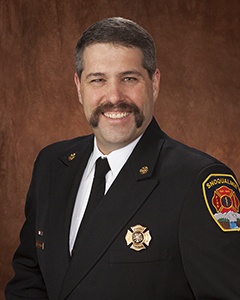After recently earning his designation as Chief Fire Officer for a second time, Snoqualmie Fire Chief and Emergency Management Director Mark Correira has plans to implement professional credentialing tools for other firefighters in his department.
The Center for Public Safety Excellence (CPSE), the only accreditation program for fire services organizations, reviews professional accomplishments of its applicants and awards designations.
“You put together a portfolio based on four or five criteria,” explained Correira.
The program “looks at job experience, size of department, education, training, community involvement, giving back to the profession, articles from trade journals and newspapers.”
The system adds up its findings and scores the applicant; those who surpass a certain threshold are moved on to an evaluator for an interview.
Following a successful interview, candidates are approved by the Commission on Professional Credentialing.
“What they are trying to do is really create a professional system that allows fire agencies to have a system to be credentialed and for it to mean something,” Correira said.
“The thing I like about it, it doesn’t look at one thing, it’s a balance of working, giving back to the community, and giving back to the profession.”
Professional process
Correira feels that this type of is process important to the fire services profession and, based on his experience earning a designation from the CPSE, he wants the fire department to adapt the process for use as an internal, professional development tool. It allows the department to be recognized by the CPSE, it professionalizes the organization and says they are meeting the standards and continue to evolve and improve over time, he explained.
Taking steps to modernize the department is part of the fire department’s strategic plan developed in 2015.
“The items in there included being adequately staffed, nationally recognized models to train our people, and pointing to data to help make our decisions,” Correira said.
“The things we do, we are going to do very well and the things we don’t do, we are going to know where to get those resources.”
The chief’s motivation for improvement comes from his career in fire services of almost 30 years.
Starting as Snoqualmie’s Fire Chief in January, 2014, Correira didn’t spend his time fixing something that wasn’t broken, but improving and evolving the existing department.
“The fire department when I got here was very well run, Chief [Bob] Rowe did a great job with the administrative side of things. The firefighters were doing a great job of staying up on their training and doing the best they could with their resources,” he said.
But, he said, in order to progress, the department would have to modernize operations.
“The organization was ripe for change and craving evolution to become a more modern fire department.”
Early start
Originally from Oxford, Mass., Correira’s first experience with firefighters came when he was just 13 years old. That experience set him on the path that led him to become Snoqualmie’s Fire Chief.
“There was a brush fire on the side of the road, and the firefighter asked me if I wanted to help put it out. From that point forward I was hooked,” he said.
“When I turned 18, I joined the volunteer fire department in my town. Then I got my EMT certification and worked on a private ambulance service, got basic firefighter training and hired full time back in Amherst.”
He joined the Amherst Fire Department in 1991. In 1998, Correira moved to Snohomish County to become the assistant chief in Edmonds where he worked under Fire Chief Tom Tomberg until the chief’s retirement in 2012. In 2014, he came to Snoqualmie.
In looking at future developments for the department, Correira said they are working on implementing an inspection program, in which a fire inspector will go out to businesses in the community to check that fire alarms are installed and ask about other fire safety measures.
The department is also looking to the upcoming Snoqualmie levy lid lift ballot measure that, if passed, would increase staffing by one firefighter, allowing the department to have three people on staff 24 hours a day.
“We will be ready to go if the citizens support it. It’s a wonderful community and supports the fire and EMS system very well,” he said. “It’s nice to have that sense of community and support and a great group of well trained firefighters to serve that community.”


